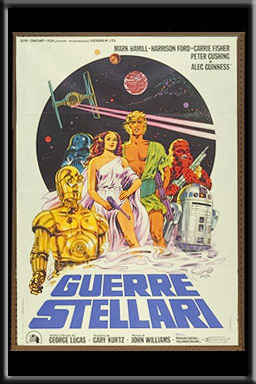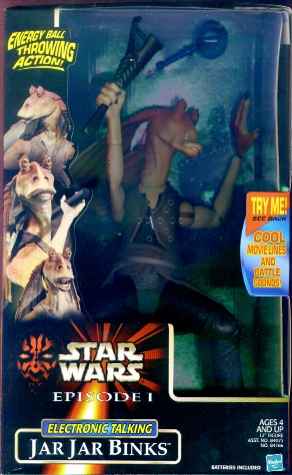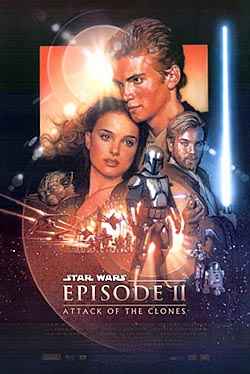|
Star WarsA long time ago, in a galaxy far, far away... Well, probably nothing happened. The search for intelligent life in the universe hasn't really been going that well. But science never stopped Star Wars from having a good time.
George Lucas had been plodding along in film-school-art-hell until crafting one of the first noteworthy "teens coming of age" movies, American Graffiti, in 1973. Made for less than $800,000, it grossed more than $110 million, making Lucas a marketable commodity. For his encore presentation, he came up with something entirely new. Star Wars was a strange conglomeration of influences, one part "Knights of the Round Table," one part New Age religion, one part Western, one part The Dam Busters, and one part samurai movie. Actually, it was about 30 parts samurai movie, specifically a little-known Kurosawa flick called The Hidden Fortress. In The Hidden Fortress, a short cheerful guy and a tall fussy guy escort a haughty princess and a warrior to an impregnable fortress. The princess gets her comeuppance and learns to relate to the common people, while the warrior engages in a saber duel with a former friend. In "Star Wars," a short cheerful robot and a tall fussy robot run around with a haughty princess and a warrior, making stops at a hidden rebel base and battling an impregnable space station. The princess gets her comeuppance and learns to relate to the common people, while the warrior engages in a lightsaber duel with a former student. The fact that Star Wars was inspired by The Hidden Fortress isn't such a big deal. After all, lots of movies are inspired by other movies. What's depressing about the Star Wars series is that almost all of them are "inspired by" Kurosawa's black-and-white masterpiece.
It might not have been high-minded, but damn, it was fun. Star Wars was a smash hit, thanks to its eye-popping effects and mythic storyline. The original movie made billions of dollars (with a B) in box office and video rentals. The series has grossed tens of billions (with a B) in box office and video rentals. Merchandise sales for the series (including toys, T-shirts, books, video games and Happy Meals) have earned scores of billions of dollars (with a lot of Bs). Lucas followed the original Star Wars with two sequels, The Empire Strikes Back and Return of the Jedi, which were good and OK respectively. The series made a star out of Harrison Ford, who played devil-may-care space smuggler Han Solo; it made B-list celebrities out of Mark Hamill and Carrie Fisher, the purported leads; and it made a high-paid telephone pitchman out of James Earl Jones, who voiced Darth Vader, the trilogy's iconic villain.
Sequels are problematic in Hollywood, but prequels are a bitch, since you already pretty much know how the story turns out. Fortunately, Lucas had inspired a slavish cult of worshippers who were more than ready to lap up any crap he dished out. And boy, did he ever dish out the crap! After years of vacillating about whether he was going to make any of these damn movies, Lucas finally announced that he was bagging the sequels but was making the prequels. Star Wars: Episode I: The Phantom Menace was a nonsensical special effects extravaganza that grossed nearly $1 billion worldwide despite being brutally savaged by the critics and even a lot of fans. The movie was loaded with digital effects which were at once absurdly inconsistent with the original movie (in that they were much more advanced), but at the same time less convincing (in that they had that CGI-fake look that you don't get from model-based special effects). It also featured alien races whose appearance and speech appeared to be directly based on some ugly 1940s-era stereotypes and caricatures of blacks and Asians, which created a surprisingly minor uproar at the time. As if all this wasn't bad enough, the "Episode One" concept was undercut by the fact that it would be nearly impossible for someone to start watching with "Episode One" and have the slightest idea what was going on. All the exposition was in the newly rechristened "Episode Four." If you were wondering what a "Jedi Knight" was, or what "The Force" was, you were out of luck. However, Lucas could be forgiven for these oversights, in light of the fact that so few people cared. Not only did "Episode One" bust a series of box office records, but it also grossed more than the original. Whatever it was that made Star Wars popular, it was apparently in there. Episode Two: Attack of the Clones was a marginally better movie, despite the ludicrous title, and it made $300 million or so, which is a lot of money, but less than Episode One and not so impressive in light of the $120 million price tag to make it (not counting promotion and marketing costs).
At 59, Lucas could conceivably change his mind about doing the sequels, with life expectancies being what they are today. After dangling the prospects of Episodes 7 through 9 in front of his drooling fans starting in 1978 and continuing for several years, he started backtracking, blaming the media for coming up with the whole sequel thing, despite numerous statements over the years about his vision. In 1999, he told Wired magazine:
"The sequels were never really going to get made anyway, unlike One, Two and Three, where the stories have existed for 20 years. The idea of Seven, Eight and Nine actually came from people asking me about sequels, and I said, 'I don't know. Maybe someday.' Then when the licensing people came and asked, 'Can we do novels?' I said do sequels, because I'll probably never do sequels. (...) If I take a few years off after the prequels ... by the time I finished the three sequels I'd be 75, and I'm not interested in doing Star Wars for the rest of my life. I have a lot of other movies I want to make". Other movies? Aside from the well-regarded Indiana Jones series, Lucas' track record on "other movies" is pretty spotty. Remember Willow? No? As a director, his main claim to fame outside of Star Wars is THX-1138, exactly the kind of thinky, ponderous, depressing sci-fi movie Star Wars was destined to overcome. Still, a trilogy of sequels to American Graffiti might be fun. Oh, wait, how much did 1979's More American Graffiti gross? $8 million? With an "M"? Never mind...
|
 In 1977, a little known classmate of Francis Ford Coppola trotted out a whole new genre of movie—it was science fiction without the science. It was called Star Wars, and it permanently changed the face of cinema.
In 1977, a little known classmate of Francis Ford Coppola trotted out a whole new genre of movie—it was science fiction without the science. It was called Star Wars, and it permanently changed the face of cinema.
 The original Star Wars was a breath of fresh air, favoring light-hearted adventure and flashy special effects compared to ponderous, depressing, thinky sci-fi contemporaries like 2001, Silent Running, and The Andromeda Strain. The movie had little regard for science, happily ignoring such improbabilities as a lightsaber (a meter-long laser beam that just ends hanging there in the air), the noise of explosions in airless space and a mysterious cosmic spiritual force that Lucas creatively called "the Force," which has more to do with
The original Star Wars was a breath of fresh air, favoring light-hearted adventure and flashy special effects compared to ponderous, depressing, thinky sci-fi contemporaries like 2001, Silent Running, and The Andromeda Strain. The movie had little regard for science, happily ignoring such improbabilities as a lightsaber (a meter-long laser beam that just ends hanging there in the air), the noise of explosions in airless space and a mysterious cosmic spiritual force that Lucas creatively called "the Force," which has more to do with  Lucas liked to talk a lot about his vision for the series. When he released The Empire Strikes Back, he titled it "Episode V," despite the fact that it was only the second movie. Lucas explained that his grand vision was to produce a prequel trilogy of three movies, and then a sequel trilogy of three movies. The original was renamed "Episode IV" in subsequent releases.
Lucas liked to talk a lot about his vision for the series. When he released The Empire Strikes Back, he titled it "Episode V," despite the fact that it was only the second movie. Lucas explained that his grand vision was to produce a prequel trilogy of three movies, and then a sequel trilogy of three movies. The original was renamed "Episode IV" in subsequent releases.  Episode Three: Title to be Determined is scheduled for a 2005 release. It might reverse the downward momentum of "Clones," by virtue of the hoped-for appearance of Darth Vader at the movie's conclusion. And since the price tag is up to $150 million this time, well, it had better be a smash hit.
Episode Three: Title to be Determined is scheduled for a 2005 release. It might reverse the downward momentum of "Clones," by virtue of the hoped-for appearance of Darth Vader at the movie's conclusion. And since the price tag is up to $150 million this time, well, it had better be a smash hit.